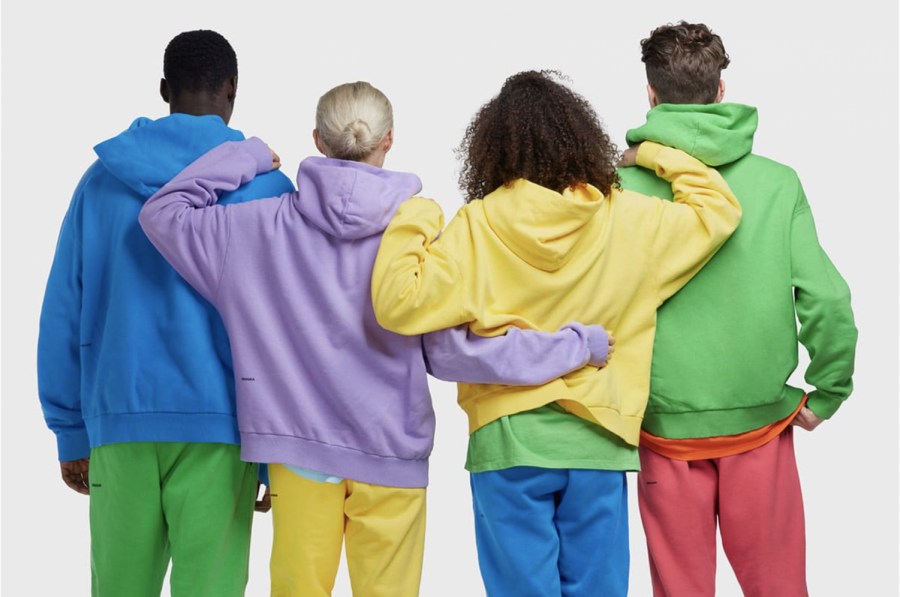Conscious Clothing: Why You Should Support Sustainable Fashion
In commercial and fast-fashion, it takes 2,700 liters of water to produce a T-shirt. Oil is also used to produce synthetic fibers, fertilizers to grow cotton, and a long list of chemicals needed to dye and finish fabric, which harms the environment. Recycled fabric saves water, oil, CO2, and 02.
With all this in mind, people have become increasingly aware of the impact of their clothing, and make more sustainable decisions about the clothing they purchase. If you care about fashion, you should care equally about sustainability. It is something that should be incorporated into daily lives so that we’re able to thrive on the only place we have to call home.
Although these are fabulous brands, none of these brands are perfect and there are still concerns about them. Each brand individually has the mission of doing the right thing even if they are highly criticized.
The clothing industry makes up 10% of the carbon emissions every year, which can be reduced by switching to sustainable fabrics, packaging, and materials. The goal of sustainable fashion is to come up with a system that does not leave the planet hurting in the end and reducing our carbon footprint.
By using recycled packing, you are putting more waste into the environment and into landfills. Sustainable packaging also reduces the water, energy, waste and materials used to make the packaging itself. The main form of sustainable fashion is using recycled fabrics and cottons to make clothing instead of producing new ones.
Although there are plenty of ways to create a renewable lifestyle, we thought fashion would be a good place to start because what’s more fun than shopping? Here are some of the best sustainable fashion brands for everyone.
Reformation
Based in downtown Los Angeles, Reformation specializes in women’s clothing and accessories. Being huge on sustainability, their clothes are made by using raw eco-friendly materials in order to benefit the environment. All the fabric they use has natural fibers which are plant-based and/or recycled. “The jeans with no rips are so comfortable and great quality. I have a pair with rips and they are so cute, but they get stretched out very easily so I have to wash them a lot. The coloring on the ripped ones have faded because of this. I also love Reformation because of their cute and comfortable dresses!” said Milken student Mandy Baeck. According to Good on You, a website that rates the sustainability of clothing, many are concerned about the chemicals used in the process of Reformation’s materials because they do not provide enough information. Aside from this, casual dresses and perfectly-fitting jeans are staple’s in most closets, and Reformation is still a great brand to look for these items and also help the environment while shopping.
House of Sunny
House of Sunny is a sustainable East London Label that created buzz after frequently being seen on model Kendall Jenner. House of Sunny produces two seasonal collections a year so the design team is set at a slower pace preventing the overproduction and overconsumption that occurs in fast fashion. House of Sunny avoids waste and overproduction by recycling and donating extra scraps whenever possible because, since 2011, their main goal has been: zero waste. With that said, their online reviews speak to their customer service. Numerous people say that their orders have taken more than a month to arrive, and often have cheaper quality than expected. In addition, House of Sunny is known to have ‘misplaced’ several of their packages and not responding to their customers when they ask for help, resulting in people paying $150 for a pair of pants that never arrives. A verified review on Trustpilot said, “I’ve spent over $1000 on this horrible company, and they couldn’t care less about my satisfaction since I can’t provide advertisement to them. Everyone I know who has ever purchased from them has been unsatisfied as well.” Although they have a large collection ranging from knitwear to gorgeous green patterns and funky animal prints, House of Sunny focuses on the latest trends and styles while including a wide range of sustainability, it seems as though they don’t always deliver and provide an all-around pleasant customer experience.
Levi’s
Levi’s Jeans have been poppin’ since founded by the Askenazi Jew Levi Strauss in 1853. The best thing about Levi’s Jeans besides their perfect fit and durability is that their materials are recycled: recycled polyester requires less energy to make than virgin polyester, which reduces dependency on fossil fuels. Levi’s Jeans uses colonized hemp, which is a textile made of fibers from the cannabis plant, because compared to cotton, it grows quicker, uses less water, and leaves behind cleaner, healthier soils. Although Levi’s Jeans has an A rating on their sustainability, they are not taking proper steps to ensure their employees and workers are making a livable wage. Levi’s is known to not compensate their workers enough, in comparison to their competitors. In addition, Levi’s animal rating needs some improvement, as they use wool, leather, and down in some of their products. On the flip side, they do not use fur, angora, or exotic animal skin/hair which is very different from many other jean brands. Overall, they are very sustainable in the sense that they put great emphasis on using less water and more sustainable material sources, but they do use some animal products in their items, making them a lesser sustainable brand.
Patagonia
Patagonia is known for its durable outdoor clothing. According to Patagonia, 68% of their fabrics are made with recycled materials. By using recycled content, Patagonia has cut emissions by 20,000 tons of CO₂ in just one year. Patagonia uses no harmful chemicals and their line of cotton clothing has been grown organically. In addition, Patagonia’s cotton line is made solely out of recycled cotton, which saves water and reduces CO₂ emissions by 45% compared to conventional cotton. Patagonia spends time investing and testing ways to improve soil health and reduce greenhouse gas emissions throughout the atmosphere. In addition to working on making their clothing more sustainable, they also have tried to fight consumerism head-on by advertising their brand by saying “Don’t buy this jacket” on their billboards, social media pages, and website. Patagonia acknowledges that the best way to help the problem is to stop contributing to it, and by educating people on consumerism and the effects it has on our environment, they are taking action and providing aid to the problem.
Pact
Pact’s trademark is, “Earth’s Favorite Clothing” which is definitely true. Pact includes Bedding, Kids clothing, sleepwear, and everyday clothing, all of which are good for the environment. Pact is more affordable and uses a high proportion of eco-friendly materials including Global Organic Textile Standard cotton which encourages customers to reduce their climate impact. Its use of eco-friendly materials limits the amount of chemicals, water, and wastewater used in production. Good on you rates Pact a ⅘ on the planet, people and animals which is a great rating compared to some of the other brands on this list. Bonus points because it’s affordable too! Pact makes one feel better about shopping because you can enjoy the clothing and also help the planet.
Pangaia
Pangaia designs comfortable and colorful clothing. Hoodies and sweatpants have been a major trend during the time of the pandemic and Pangaia does a great job of creating sweat-suits that are both trendy and great for the environment. Pangaia utilizes recyclable elements such as using plastic bottles to form yarn, which can be used to create T-shirts, hoodies, and sweatpants. Written on each article of clothing is, “This hoodie is colored with an environmentally friendly dye, created using a recycled water system. The fabric is made from a recycled and organic cotton mix”. One would think these minimalist outfits would cost less, being that there is not much to each product, but due to the process each article of clothing undergoes, each hoodie and sweatpants set together comes out to be a grand total of 300$. “The set is super comfortable and trendy right now and I love the message this brand spreads. The sweatpants are made from a thick and good-quality material,” said Milken Student, Sophia Yadidi.
The most sustainable way to shop overall would be to shop less and to not over-consume. Find ways to clean out your own closet and make use of each item. Buy from second-hand, vintage, and thrift stores before shopping at a regular store to also minimize your consumption. If all else fails, purchase from these sustainable brands we’ve provided. Shop smart and consciously!

Alexa Dardashty is a senior, and Co-Editor-in-Chief of the Roar here at Milken. She is also the Social Media Manager. Alexa also loves her maltese, Bruno....

Rachael is a senior at Milken in her first year with The Roar. She decided to join The Roar for her love of writing articles about fashion, current events,...

Leila Soleimani is a junior at Milken in her first year with The Roar. She is currently the Co-Representative of her house and loves helping her fellow...

Elinor is a senior at Milken in her first year with The Roar. Her favorite topics to write about include fashion, personal stories, and culture. In her...



